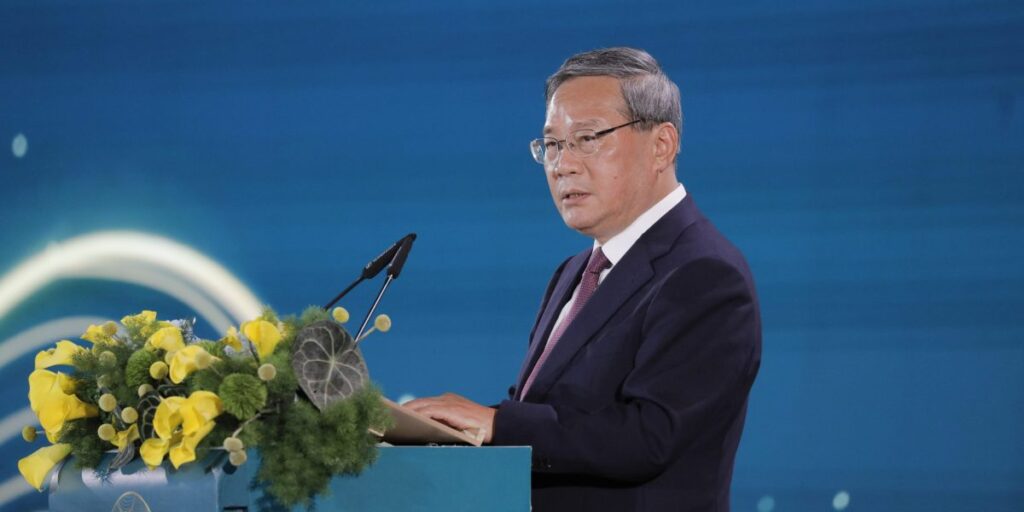Beijing No. 2 wants companies to fully participate in the development of China, as it joins the leaders of ASEAN and the Gulf Cooperation Council chrome at all at all.

Chinese Prime Minister Lee Qiang, No. 2 in Beijing, pledged to open the second largest economy in the world in “quality of products from all over the world” because he pledged to deepen economic relations with both Southeast Asia and the Middle East.
“We need to enable local and international rotation … so that companies around the world, including companies from Asia and the Gulf Cooperation Council countries, can fully participate [in] “The development of China,” told me, told me the delegates at the Economic Forum of the ASEAN-GCC-CC in Fortune, which was held in Kuala Labor on May 27.
I had in the capital of Malaysia to join a summit between the leaders of the Association of Southeast Asian Countries (Asia) and the Gulf Cooperation Council (GCC) at the first event ever including leaders from all three economic regions. The tripartite summit was held alongside the annual Asian Summit, and a bilateral meeting was held between Southeast Asia and the Middle East.
China is looking to formulate new economic relations with other regions after the United States re -launching its trade war against Beijing. as far as 16 million jobs in China It is exported to the Americans, as Goldman Sachs was estimated earlier this year.
Beijing officials met with leaders in areas such as Southeast Asia and latin america To try to build a unified front against the Trump tariff, while it is also trying to open new markets for its goods that may be banned now from the United States
He told me on Wednesday: “Economic globalization suffers from heavy strikes before. The values we follow all the time, such as peace, development and cooperation, winning victory, are facing a great challenge.” “Treating these issues correctly will bring great opportunities for the countries of our three aspects.”
Slow economy in China
It can harm the trade -off war between the United States of China Struggle already The Chinese economy, which slowed under the weight of stagnant consumption and the property debt crisis.
However, investors and economists hope to convince commercial winds Beijing to cancel the launch of the stimulus that have been long before.
On Wednesday, Lee said that Beijing has followed more “proactive” policies to support the market. “They will provide strong support for expanding the total demand for the market.” He added that Beijing will continue to enhance the adaptation between Contractual “in future policy.
The United States has Stop temporarily From its tariffs on China – which reached a total of 154 % – as Beijing and Washington continues commercial negotiations. Chinese goods are now facing a 30 % tax when they enter the United States; China, in turn, is now a 10 % tariff on American goods. (Trump also stopped most of the so -called mutual definitions against the rest of the world).
Despite stopping, Trump’s statements still generate uncertainty for governments and investors. On Friday, Trump promised to slap a 50 % tariff on European goods by June 1, saying the negotiations “do not go anywhere.” he This threat canceled By Sunday, he said again that the customs tariff was hanging until early July.
The American President also threatened 25 % tariff On the Apple iPhone made outside the United States, Apple has transferred some manufacture to India, and away from China, to avoid the American tariff. However, Trump called on such measures on Friday, noting that even India’s iPhone devices will be subject to tax.
This means that China is looking for new markets for its products. “We must expand the regional openness firmness and the development of a large market,” he said to me Regional leaders earlier on Tuesday.
However, some Southeast Asian countries are cautious about a flood of cheap Chinese exports, which are now likely to be prevented from entering the United States without deterrent, which may lead to a “introductory chain” where countries impose commercial barriers on the re -directed exports.
On Wednesday, I was optimistic about the existence of an area to increase trade between the three different regions. Despite the account of a quarter of the world population and global economic production, he told me that the three economies represent only 5.4 % of global trade.
“We have great potential to exploit it,” he said. “This is the influence that we can use in the future.”
This story was originally shown on Fortune.com



